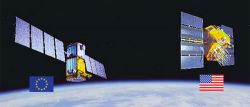
As emphasized in the European Commission (EC) “white paper” on European transport policy for 2010, the European Union (EU) needs an independent satellite navigation system. Galileo is Europe’s contribution to the global navigation satellite system of systems (GNSS) and has committed itself from the very beginning to developing a signal plan that would provide sufficient independence from GPS, while also being compatible and interoperable with it.
As emphasized in the European Commission (EC) “white paper” on European transport policy for 2010, the European Union (EU) needs an independent satellite navigation system. Galileo is Europe’s contribution to the global navigation satellite system of systems (GNSS) and has committed itself from the very beginning to developing a signal plan that would provide sufficient independence from GPS, while also being compatible and interoperable with it.
The historic Agreement on the Promotion, Provision, and Use of Galileo and GPS Satellite-Based Navigation Systems and Related Applications between the United States and the European Commission (EC) signed in 2004, wherein both parties agreed to work together, affected the originally planned Galileo signals but has intensified the cooperation on interoperability and compatibility issues between Galileo and GPS for the maximum benefit of GNSS users worldwide.
The final touch to the Galileo signal plan was achieved in 2006 when the Working Group on GPS and Galileo compatibility and interoperability, under the auspices of the 2004 agreement, finally settled on a new modulation for the common signal in the E1/L1 frequency, namely the multiplex binary offset carrier, or MBOC for short. This decision was pursuant to efforts mainly driven by the European side and fully recognized by the U.S. representatives.
The journey to the signals Galileo has today for its baseline has been tedious and long, but from the outset the journey has followed a consistent logic. At the very beginning, one of the main challenges that Galileo set for itself was to offer three wideband signals, satisfying at the same time the requirements of the mass market and pushing the potential performance of the navigation signals to their natural limits.
This article will try to shed some light on the long process that has led to the signal baseline we have today. Special care will be placed on describing all the modulations of the final Galileo Signal Plan.
(For the rest of this story, please download the complete article using the link above.)


